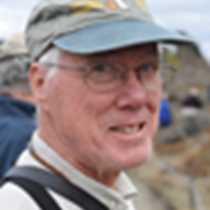Booth & Petermann Islands, Antarctica
In Antarctica you take whatever you are given. Earlier in the week Antarctica gave us brilliant clear, sunny weather in the Weddell Sea. We took it, and we were glad for it. Today, as we made our way down the west side of the Peninsula, Antarctica gave us a summer snowstorm. We took that, too, in the best of spirits. In the early morning we passed through the narrow, ice-lined Lemaire Channel, our Captain delicately avoiding the icebergs that narrowed it even further. That passage completed, we tucked into a protected harbor at the south end of Booth Island. The view from the dining room was pretty stunning: a calf humpback whale (like many of us, on its first voyage to Antarctica) breaching over and over and over.
Our morning was devoted to kayaking among giant icebergs, and walking on the snow and rocks of Booth Island. Here, in 1904, the French explorer Jean Baptiste Charcot overwintered in his expedition ship Français. Learning from the travails of the earlier Belgian Antarctic expedition, Charcot paid great attention to the comfort of the members of his expedition: private sleeping cubicles, old newspapers, periodic presentations, a daily ration of wine and spirits, and a choice of meals selected from a menu; can you imagine such a thing in the Antarctic?!
Booth Island is now one of the few locations where we find all three of the brushtail penguin species (gentoo, Adelie, and chinstrap) breeding together, and we traipsed up the hill to view them.
Charcot returned to France in 1905 after a very successful expedition. The published results filled many volumes. He was a national hero. Three years later he was back again with a new ship, the Pourquoi-Pas? (in French, "Why Not?"). This time the party overwintered in a small inlet on Petermann Island, close to the previous site, and this was our afternoon destination. Today it is used by a new generation of scientific explorers: members of the Oceanites research team monitoring the abundance and breeding success of penguins and other birds on the Antarctic Peninsula and its fringing islands. Oceanites is a conservation partner of Lindblad Expeditions and the National Geographic Society. We offered the three resident scientists a hot shower (much appreciated) and a meal; they offered us a visit to their island home. The two phases of exploration, 100 years apart, come together when the scientists compare present populations of breeding Adelie and gentoo penguins with the numbers reported by Charcot. Adelies have declined from about 1000 to fewer than 400 breeding pairs, while gentoos have increased from only 50 to over 2,700 pairs. Both changes are consistent with trends seen elsewhere around the Peninsula. Today penguins of both species were coping with the summer snowstorm but, fair weather or fowl, the penguins must march to and from the sea to bring food to their hungry young, and the scientists have nests to count. And so it is in the Antarctic.
In Antarctica you take whatever you are given. Earlier in the week Antarctica gave us brilliant clear, sunny weather in the Weddell Sea. We took it, and we were glad for it. Today, as we made our way down the west side of the Peninsula, Antarctica gave us a summer snowstorm. We took that, too, in the best of spirits. In the early morning we passed through the narrow, ice-lined Lemaire Channel, our Captain delicately avoiding the icebergs that narrowed it even further. That passage completed, we tucked into a protected harbor at the south end of Booth Island. The view from the dining room was pretty stunning: a calf humpback whale (like many of us, on its first voyage to Antarctica) breaching over and over and over.
Our morning was devoted to kayaking among giant icebergs, and walking on the snow and rocks of Booth Island. Here, in 1904, the French explorer Jean Baptiste Charcot overwintered in his expedition ship Français. Learning from the travails of the earlier Belgian Antarctic expedition, Charcot paid great attention to the comfort of the members of his expedition: private sleeping cubicles, old newspapers, periodic presentations, a daily ration of wine and spirits, and a choice of meals selected from a menu; can you imagine such a thing in the Antarctic?!
Booth Island is now one of the few locations where we find all three of the brushtail penguin species (gentoo, Adelie, and chinstrap) breeding together, and we traipsed up the hill to view them.
Charcot returned to France in 1905 after a very successful expedition. The published results filled many volumes. He was a national hero. Three years later he was back again with a new ship, the Pourquoi-Pas? (in French, "Why Not?"). This time the party overwintered in a small inlet on Petermann Island, close to the previous site, and this was our afternoon destination. Today it is used by a new generation of scientific explorers: members of the Oceanites research team monitoring the abundance and breeding success of penguins and other birds on the Antarctic Peninsula and its fringing islands. Oceanites is a conservation partner of Lindblad Expeditions and the National Geographic Society. We offered the three resident scientists a hot shower (much appreciated) and a meal; they offered us a visit to their island home. The two phases of exploration, 100 years apart, come together when the scientists compare present populations of breeding Adelie and gentoo penguins with the numbers reported by Charcot. Adelies have declined from about 1000 to fewer than 400 breeding pairs, while gentoos have increased from only 50 to over 2,700 pairs. Both changes are consistent with trends seen elsewhere around the Peninsula. Today penguins of both species were coping with the summer snowstorm but, fair weather or fowl, the penguins must march to and from the sea to bring food to their hungry young, and the scientists have nests to count. And so it is in the Antarctic.




